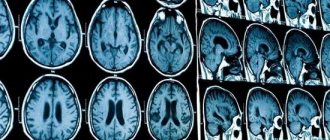Many people are interested in what a neurologist treats in adults and when to contact him.
A neurologist is a medical specialist who diagnoses and treats pathologies affecting the central and peripheral nervous system.
To become a neurologist, you need to graduate from a medical school with a degree in general medicine or pediatrics and specialize in neurology.
When to consult a doctor
It is recommended to consult a specialist if:
- headaches and dizziness, especially if they are accompanied by nausea and increased blood pressure;
- shooting pains in the face;
- pain in the limbs, back and neck;
- decreased sensitivity (pain, temperature);
- progressive muscle weakness;
- stiffness in the body;
- trembling, tingling and numbness of the limbs;
- uncontrolled movements of the arms or head;
- convulsions, fainting states;
- insomnia or increased sleepiness;
- constant night awakenings;
- apathy, depression;
- increased nervousness, irritability;
- panic attacks;
- chills or hot flashes;
- loss of balance and ability to coordinate movements, unsteadiness of gait;
- memory impairment;
- violation of taste and smell;
- periodic loss of vision;
- the appearance of tinnitus;
- speech disorders.
Often, diseases of the nervous system manifest themselves with uncharacteristic symptoms. In such cases, a therapist can refer you for a consultation with a neurologist.
It is recommended to visit a specialist annually for preventive purposes.
Centuries-old history
Science Neurology is a respectable lady. Doctors of ancient Egypt and ancient Greece also described symptoms of paralysis and epilepsy. And ancient Chinese healers skillfully practiced acupuncture.
This science and its followers received full recognition in the 19th century with the advent of Jean Martin Charcot. The scientist devoted his life to searching for relationships between the manifestations of diseases and the area of damage to the nervous tissue.
Another great neurologist is George Parkinson. He discovered Parkinson's disease and described it in detail.
In Russia, the development of Neurology is associated with such great names as Sergei Korsakov, Ivan Sechenov, Vladimir Bekhterev, Ivan Pavlov, Alexey Kozhevnikov. Thanks to the latter scientist, Russian neuropathology became a separate clinical discipline. In addition, Alexey Kozhevnikov created the world's first neuropathological clinic and described the classic manifestations of special seizures. Later they received the name “Kozhevnikov epilepsy.”
What diseases does the specialist deal with?
Let's try to find out when a neurologist will help, what he treats in adults.
The doctor treats neurological disorders:
- intracranial hypertension;
- nervous tics, tremors;
- cranial and spinal injuries, as well as their consequences;
- Alzheimer's and Parkinson's diseases;
- multiple sclerosis;
- stroke and its consequences;
- paresis and paralysis;
- neuralgia, neuritis, plexitis;
- migraines, headaches;
- pain in the neck and back;
- painful prolapses caused by nerve damage;
- seizures, epilepsy;
- cauda equina syndrome;
- torsion dystonia;
- encephalopathy;
- osteochondrosis;
- radiculitis;
- intervertebral hernia;
- Wilson-Konovalov disease;
- Crouzon and Dandy-Walker syndromes;
- arachnoiditis;
- leukodystrophy;
- myasthenia gravis;
- neurofibromatosis;
- blepharospasm;
- syringomyelia;
- vertebrobasilar insufficiency;
- meningitis, encephalitis;
- insomnia;
- sleep apnea syndrome;
- tumors of various etiologies.
The listed diseases are often accompanied by changes in mentality and behavior. In this case, it may be necessary to consult a psychiatrist or psychotherapist.
What diseases can a neurologist help you cope with?
This specialist specializes in the prevention and treatment of the following conditions:
- diseases of peripheral nerves (sciatica, neuritis, various types of polyneuropathy);
- vascular pathologies (stroke, chronic cerebral circulatory insufficiency, hypoxia of newborns);
- demyelinating diseases, which are characterized by destruction of the nerve sheath and disruption of nerve conduction (a well-known example of a disease from this group is multiple sclerosis);
- migraine;
- epilepsy;
- injuries of the central nervous system and peripheral nerves;
- diseases of the autonomic nervous system (vegetative-vascular dystonia);
In addition, there are a number of pathologies that, if detected in a patient, require consultation with a specialist. What diseases does a neurologist treat together with other doctors? Infections of the nervous system (poliomyelitis, meningitis), neoplasms of the central nervous system, various neuroses. The participation of a neurologist in the process of diagnosis and treatment of these pathologies allows us to achieve successful results in their treatment.
What does a neurologist treat in children?
A pediatric neurologist will help with:
- developmental delay;
- attention deficit symptom;
- Down syndrome;
- hyperactivity;
- convulsions and fainting;
- epilepsy;
- polio;
- hydrocephalus;
- phenylketonuria;
- West syndrome;
- cerebral palsy;
- birth and hypoxic lesions.
The specialist also monitors infants, which allows timely detection and elimination of the slightest pathologies.
How to become a neurologist
Before you start working in the field of neuroscience, you must first acquire the relevant knowledge and skills. Namely:
1. Obtain a higher medical education:
2. Complete residency in Neurology
In addition, the ability to correctly “read” X-ray and tomographic images is necessary.
Skills in manual therapy and osteopathy are also desirable.
The work of this specialist also requires:
- analytical mind;
- good memory;
- skills to communicate with people;
- balance, endurance and patience;
- readiness to provide assistance at any time;
- a mood for “continuous learning”: reading scientific articles, attending conferences, etc.;
- emotional stability;
- Ability to detach emotionally and maintain professionalism.
How does a neurologist differ from a neurologist?
Now you know who a neurologist is and what he treats in adults. Who is a neurologist, and how does he differ from a neurologist? It turns out that these are two names of the same profession.
In connection with frequent disorders in the functioning of the nervous system, a science was created that studied the structure and functions of the nervous system, clarified the mechanism of failures, and developed methods to cure existing pathologies. It was called neurology, and specialists began to be called neuropathologists. In the 80s of the last century, changes occurred in the Ministry of Health, as a result of which neurologists were renamed neurologists.
What can the doctor prescribe?
After diagnosis, the neurologist prescribes treatment. It can be conservative and operative.
Conservative treatment methods include:
1. Use of medications
2. Physiotherapy
3. Therapeutic gymnastics
Each of the nervous diseases has certain risk factors. They can be different habits, types of work, psychological conditions. The neurologist analyzes the patient’s lifestyle, identifies these factors and makes recommendations for eliminating them.
In other words, changes in the patient’s lifestyle play a very significant role in the treatment of nervous diseases.
Important! Nerve tissue recovers slowly. Therefore, good neurologists always try to preserve it, using the entire range of conservative treatment methods. And only in the most severe cases, the neurologist resorts to radical treatment - surgery.
The operations are performed by neurosurgeons.
How does the consultation work?
At the first appointment, the doctor listens to the patient’s complaints and collects an anamnesis of the disease. He asks about age, marital status, characteristics of professional activity, finds out the localization, nature and intensity of pain, factors causing pain, the presence of chronic and hereditary diseases. Then he examines the patient, conducts palpation and tests to assess visual and olfactory acuity, speech skills, reflexes, coordination of movements, sensitivity, and muscle strength.
Causes of neurological pathologies
- Age-related changes in the body.
- Disruption of the circulatory system.
- Injuries and bruises.
- Infections. A huge number of viruses, bacteria and parasites can infect the nervous system. For example, herpes virus, chickenpox, toxoplasmosis.
- Intoxication of the body with various substances (chemical, toxic, narcotic, medicinal)
- Heredity.
- Poor nutrition and, as a result, lack of vitamins.
- Malignant tumors.
Diagnosis and treatment
After a visual examination, the neurologist refers the patient for examination, which may include:
- echoencephalography of the brain;
- neurosonography;
- myelography;
- electroencephalography;
- electroneuromyography;
- cerebral angiography;
- ultrasound encephaloscopy;
- Doppler ultrasound scanning;
- CT, MRI or PET;
- lab tests;
- lumbar puncture.
Based on the diagnostic results, the doctor makes a diagnosis, determines the cause of the pathology and individually selects the optimal treatment, taking into account the type and stage of the disease, as well as the general condition of the patient and the presence of other diseases. It includes taking medications, injections, massage, physiotherapeutic procedures, physical therapy, biofeedback therapy, and psychotherapeutic techniques. In severe cases, surgery may be necessary.
During an exacerbation of the disease, the doctor may prescribe bed rest. During the treatment process, he monitors the patient’s condition and, if necessary, makes treatment adjustments. At the end of the treatment course, the neurologist gives advice to avoid relapses.
Methods for diagnosing nervous diseases
Diagnosis of diseases of the nervous system has a number of features. Therapists, surgeons and representatives of other specialties use examination, percussion, palpation and auscultation of the affected area to recognize the disease. However, the brain and spinal cord are not accessible to direct examination using the methods mentioned. A neurologist can give a patient a correct diagnosis only if a disorder of the functions of the nervous system is identified.
The examination always begins with a survey, during which the specialist assesses the patient’s state of consciousness and the characteristics of brain activity: speech, attention, memory. While clarifying complaints and clarifying the features of the onset and course of the disease, the neurologist notes the patient’s ability to understand the meaning of speech addressed to him and the ability to concentrate on the topic of conversation.
What does a doctor check if a brain disorder is suspected? In this case, the neurologist will ask the patient to perform one of the simple tasks: draw something, write or read a few phrases out loud. In order to understand whether the patient can perform a purposeful action, the doctor asks him to show him how to light a match or brush his teeth, or to repeat a gesture.
The specialist also necessarily examines the patient’s reflexes using a special neurological hammer - an instrument that is used only by doctors of this specialty. At the same time, it is noted how pronounced and symmetrical the reaction is in each of the areas.
If there is a suspicion of damage to the muscles of a certain group (paresis), the specialist asks the patient to straighten and bend the limb and assesses the volume of active movements. A device called a dynamometer helps study muscle strength. Also, in some cases, the neurologist tests the sensitivity of the skin using irritants such as a small needle or a soft brush.
Additional research methods used by a neurologist in his practice include:
- Electroencephalography (EEG), with which a doctor can analyze the functioning of the brain based on its electrical activity. The procedure is carried out at rest or with the use of stimuli.
- CT and MRI. Due to their high accuracy, these methods make it possible to determine the nature and localization of hemorrhage in brain tissue, detect a neoplasm of the nervous system, assess the degree of compression in radicular syndrome, etc.
- Duplex scanning, which makes it possible to assess blood flow in the vessels of the neck.
- Electromyography, during which electrical potentials are recorded from the surface of the muscles.
- Rheoencephalography, which helps to detect areas of impaired blood flow in the vessels of the brain. This procedure can be prescribed to a patient if there are contraindications to more informative CT and MRI.
- Neurosonography is an ultrasound examination of the brain. It can only be performed on small children until their large fontanel closes.
Patients with infectious diseases of the nervous system in most cases require a lumbar puncture, during which cerebrospinal fluid is taken and its characteristics are examined. Also, in some cases, to establish the correct diagnosis, the doctor refers the patient for consultation to related specialists. In this case, the neurologist can be helped by an ophthalmologist, endocrinologist, cardiologist and other doctors.
Advice from a neurologist
The proper functioning of the nervous system is important for the health of the body, as it controls the coordinated functioning of all organs.
To avoid nervous diseases, it is recommended to follow several rules:
- eat rationally;
- sleep 7-8 hours a day;
- to refuse from bad habits;
- doing physical exercise;
- walk in the fresh air for at least 2 hours.
You can make an appointment with a neurologist at Ryazanova Private Office LLC by phone or using the online form “Request a call back”. Our administrator will call you back and select the best time for you to visit a specialist.
Signs of neurological diseases
Diseases of the nervous system do not appear immediately, but develop slowly and gradually. They lead to dangerous, severe and irreversible consequences - paralysis, disability, loss of intelligence. As a person ages, this risk only increases.
With peripheral paralysis, muscle contractility is lost, a person cannot move independently, he does not control his own. Paresis is a partial loss of motor activity in the muscles. In both conditions, muscle atrophy develops, muscle volume decreases, tendon reflexes are absent, and muscle tone is lost.
Central paralysis is manifested by increased muscle tone and increased speed of tendon reflexes. When the basal ganglia, which are located in the white matter of the brain, are damaged, the regulation of motor and autonomic function occurs, which affects the motor skills of movements. They slow down, become involuntary, trembling (tremor) appears, and muscle tone changes. If the cerebellum is damaged, coordination of movements is impaired, speech becomes unclear and slow, and the limbs weaken.
Make an appointment
Career
While working, doctors are awarded qualification points. They serve as confirmation of accreditation and take into account the presence of:
- complex manipulations;
- participation in scientific and practical conferences, seminars;
- publication of articles, books, dissertation defense.
The accreditation commission, which sums up the points and makes a decision on the possibility of further work, meets every 5 years. If there are not enough points, the doctor is deprived of the right to continue working.
All the doctor’s achievements, his level of professionalism and experience are reflected in his qualification category. It is assigned by a special commission based on the results of his written research work. Obtaining a category is voluntary, but its absence hinders career growth.
Pros and cons of the profession
First of all, working as a neurologist gives you a sense of satisfaction. This is a complex discipline, and a person who has trained as a neurologist has every right to feel proud.
Other benefits:
- High earnings. These doctors are valued in any medical institution and often earn much more than their colleagues working in other specialties.
- Opportunity to retrain. For example, in psychiatry - these areas have a lot in common. Other related specializations are neurosurgery and medical rehabilitation.
- Opportunity to engage in private practice. Unlike a surgeon or therapist, a neurologist can easily open his own office and see patients. True, this requires additional training, but all costs quickly pay off.
- Good SSS during training, as well as a short residency training period – 2 years.
Residency training is quite expensive, and there are not many budget places. This can be attributed to the disadvantages of the profession. Other disadvantages: the high complexity of the specialty and a lot of competition.
Features of the profession
An important feature is the demand for this specialty in any medical institution. Many people suffer from neurological diseases; most diseases are accompanied by problems with the nervous system, so medical specialists often refer their patients to a neurologist.
Responsibilities of a neurologist:
- observes and treats patients in outpatient and inpatient settings;
- conducts diagnostics and examinations: ultrasound, ultrasound, angiography;
- provides emergency and routine medical care, including in intensive care;
- prescribes additional examinations: electrolyte balance, prothrombin index (PTI), echocardiography;
- conducts medical examinations and medical examinations;
- participates in commissions for issuing permits to carry weapons and drive vehicles;
- issues sick leave, referrals for medical examination, and other certificates.
Personal qualities
Neurology is one of the most complex branches of medicine, so it is only suitable for particularly hardworking and diligent specialists.
What is important for a neurologist:
- Working with patients with neurological problems requires thoughtfulness and a desire to constantly grow and develop.
- You need to learn to empathize with the patient, realize the value of people's lives, be attentive and polite.
- It is necessary to have great patience and strong nerves, to remain calm even in an extreme situation.
Being a neurologist is actually very difficult. This profession requires a lot of strength, hard mental work, and takes a lot of time.
Who is a neurologist?
Neuropathologist is an outdated name for the specialization. In modern neurology and medical institutions, this term is not used so often, and in doctors’ offices it is difficult to see a “neurologist” sign. This term is more often used by patients themselves, especially those who lived in the distant Soviet Union. There is no difference between a neurologist and a neuropathologist, especially when the patient is concerned about symptoms associated with damage to the spinal cord or brain. In this case, the main thing is to find a good specialist who will help diagnose the disease and provide appropriate treatment.
The clinic on Belomorskaya is attended by a neurologist (neurologist) of the highest category with extensive experience. It provides a wide range of services for the treatment and diagnosis of diseases of the central nervous system. At the clinic, the patient has the opportunity to undergo examination using high-quality equipment and receive an individual approach.









